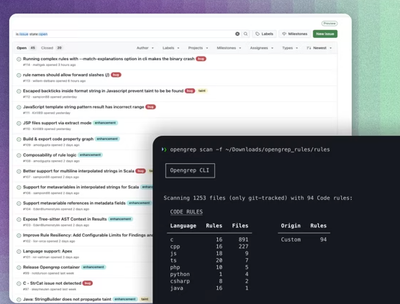
Research
Security News
Lazarus Strikes npm Again with New Wave of Malicious Packages
The Socket Research Team has discovered six new malicious npm packages linked to North Korea’s Lazarus Group, designed to steal credentials and deploy backdoors.
dyna-ts-react-module-boilerplate
Advanced tools
This is a Webpack boilerplate for Typescript React Components to use as a module in other apps or other modules.
Develop, debug, test, Storybook, and distribute React component(s).
Replace the my-component with the name of your new module.
git clone http://github.com/aneldev/dyna-ts-react-module-boilerplate my-component
cd my-component
yarn run create
That's it.
create-react-app different?It is different because create-react-app creates React applications and includes everything an application needs.
The dyna-ts-react-module-boilerplate creates React modules (reusable components). It creates React components that will be used in React applications or other modules.
| React version | Git entity | Name |
|---|---|---|
| 15 | tag | v4.1.5 |
| 16 | branch | master |
| 17 | branch | react-v17 |
*.module.less/scss filename pattern)undefined or null values)This boilerplate runs only under Linux.
Scripts of this package are not designed for Windows command line!
For windows users there are multiple ways:
The source code of your project is under the /src/ folder only. The distributed module is what exported from the /src/index.tsc only.
There are loaders for various files, like: .less, .scss, .svg, .jpg, etc.. Loaders are loaded in /webpack.loaders.js, where you can add your own loaders that will be used for all tasks (npm scripts).
You can develop using the Storybook or create your app. In any case on yarn release, only what is exported by src/index.tsx will be released.
If you want to add a dependency that will be used only in a Story or in your custom app install is as dev dependency.
Stories are all files with extension .stories.tsx. There is already a stories folder, but story files would be anywhere.
yarn storybook
Or yarn storybook-at <custom port> to open Storybook on custom port.
If you don't want to use the Storybook, you can create your app.
Under the /dev/app/ folder, there is a small web application that can use your module component in different ways.
This way, you can develop, debug, and create a demo of your component.
yarn start
or, if you want to start it to a different port yarn start-to -- 3232 to start in port 3232.
Like an App, this boilerplate uses the dyna-showcase where it is a very light StoryBook like solution.
One of the benefits is that it is speedy compared with StoraBook, and you can see the actual edges of the components (for high fidelity dev).
It is ideal for development, but you can easily replace it with yours, yarn remove dyna-showcase, and write your app under the /dev folder.
StoryBook is still available!
yarn lint
Update the tslint.json with your own preferences.
Run yarn build-analyze and check which dependencies will be delivered in your module.
For tests, this boilerplate uses the Jest.
Test files can be anywhere but they should have a name *.(test|spec).(ts|tsx|js|jsx). There is a tests/ folder if you want to use it but this is not mandatory.
Call yarn test to run your tests and coverage.
Call yarn test-watch to run your tests after any change, with no coverage.
yarn build
Build creates your distributable version of your component under ./dist. Typescript's declaration will be there too.
You don't need to use the build, since the release script calls the build.
You will need this is if you have linked this package with another local package (like yarn link or so).
yarn release
The output is not compressed, while it is intended to be used in other apps where it will be bundled and compressed. This also makes your component debuggable.
For private packages, where you don't want to expose them to yarn, remove the yarn pulish call from the publish-push script.
You can exclude dependencies from the distributed bundle by declaring them in the /webpack.dist.config.js. By default, all dependencies are declared there.
In case that the yarn link doesn't work for any reason, this boilerplate offers a unidirectional sync mechanism. It updates other modules (npm packages) that depend on it.
./syncExternalsList.sample.js to ./syncExternalsList.js once only../syncExternalsList.js list with external apps you want to keep them sync.yarn sync-externalsIf you use the Ubuntu shell of Win10, in the ./syncExternalsList.js you can add a windows path prefixing it with the *tus*, which stands for to ubuntu shell.
For example, check the 2nd line of ./syncExternalsList.sample.js.
Note: the ./syncExternalsList.js is git ignored!
If you are interested in a typescript module, with other words if you want to implement everything as we do here but without any react components, check this out this dyna-ts-module-boilerplate repo.
FAQs
React Component / Module boilerplate
The npm package dyna-ts-react-module-boilerplate receives a total of 2 weekly downloads. As such, dyna-ts-react-module-boilerplate popularity was classified as not popular.
We found that dyna-ts-react-module-boilerplate demonstrated a healthy version release cadence and project activity because the last version was released less than a year ago. It has 0 open source maintainers collaborating on the project.
Did you know?

Socket for GitHub automatically highlights issues in each pull request and monitors the health of all your open source dependencies. Discover the contents of your packages and block harmful activity before you install or update your dependencies.

Research
Security News
The Socket Research Team has discovered six new malicious npm packages linked to North Korea’s Lazarus Group, designed to steal credentials and deploy backdoors.

Security News
Socket CEO Feross Aboukhadijeh discusses the open web, open source security, and how Socket tackles software supply chain attacks on The Pair Program podcast.

Security News
Opengrep continues building momentum with the alpha release of its Playground tool, demonstrating the project's rapid evolution just two months after its initial launch.